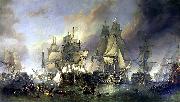All Clarkson Frederick Stanfield's oil paintings


|
|
|
| ID |
Image |
Oil Pantings, Sorted from A to Z |
Other Information |
| 72219 |
 |
Action and Capture of the Spanish Xebeque Frigate El Gamo |
Date 1845[1]
Medium Oil on canvas
Dimensions Width: 183.9 cm (72.4 in). Height: 132.1 cm (52.01 in).
cyf |
| 22811 |
 |
Burg Eltz (mk22) |
1838
Oil on wood panel
51 x 40.5 cm
Bonn,Rheinisches Landesmuseum |
| 73288 |
 |
H.M.S 'Victory' towed into Gibraltar, |
H.M.S 'Victory' towed into Gibraltar, watercolour by Clarkson Stanfield. Probably a study for Stanfield's large oil painting of the subject, his second of the Battle of Trafalgar, that he exhibited at the Royal Academy in 1853. HMS Victory, in full starboard view, is towed into Gibraltar by HMS Neptune, seen ahead in starboard stern view, seven days after the battle |
| 27965 |
 |
On the Dogger Bank |
1846
Oil on canvas 76.1 x 69.8 cm(30 x 27 1/2in)
Victoria and Albert Museum London (mk63) |
| 86666 |
 |
St. Michael's Mount, Cornwall |
Oil on canvas
cjr |
| 91454 |
 |
St. Michael's Mount, Cornwall |
oil on canvas
cyf |
| 86333 |
 |
The Battle of Trafalgar |
19th century
Medium Oil on canvas
cyf |
| 24311 |
 |
The Opening of London Bridge (mk25) |
I August 1831 1832 |
| 28214 |
 |
Venice:The Dogana and the Salute |
1831
watercolour and bodycolour 22.2 cm x 31.8 cm(8 3/4 x 12 1/2 in)British Museum London (mk63) |
| 74993 |
 |
Victory |
English: H.M.S 'Victory' towed into Gibraltar, watercolour by Clarkson Stanfield. Probably a study for Stanfield's large oil painting of the subject, his second of the Battle of Trafalgar, that he exhibited at the Royal Academy in 1853. HMS Victory, in full starboard view, is towed into Gibraltar by HMS Neptune, seen ahead in starboard stern view, seven days after the battle.
Date Pre-1853
cyf |
|
|
| Clarkson Frederick Stanfield
|
| English Painter, 1793-1867
He is often wrongly referred to as William Clarkson Stanfield. The son of Mary Hoad and James Field Stanfield, an Irish actor and author, he was apprenticed to a heraldic coach painter at the age of 12, but in 1808 he abandoned this and went to sea in a collier. In 1812 he was press-ganged and spent two years on HMS Namur, the guard-ship at Sheerness. After being discharged as the result of an injury in 1814, he joined the merchant navy, sailing to China in the Indiaman Warley in 1815. Soon after his return in 1816 he missed his ship and became a scene painter, first at the Royalty Theatre, Stepney, and then at the Royal Coburg, Lambeth. There he was later joined by David Roberts, who became a lifelong friend, and in 1822 both men were employed as scene painters at the Theatre Royal, Drury Lane. During the next 12 years Stanfield established himself as the most talented scene painter of his day, causing a sensation with some of his huge moving dioramas such as the scenes of Venice in the pantomine Harlequin and Little Thumb (1831). Meanwhile he was building an equally impressive reputation as an easel painter. He first exhibited at the Royal Academy in 1820 and continued to exhibit there regularly until his death. He was elected ARA in 1832 and RA in 1835.
. Related Artists to : | Gioacchino Toma | Conrad Witz | Jose Mercedes Ortega | Henry Sargent | Charles west cope RA | |

|
|

|
|